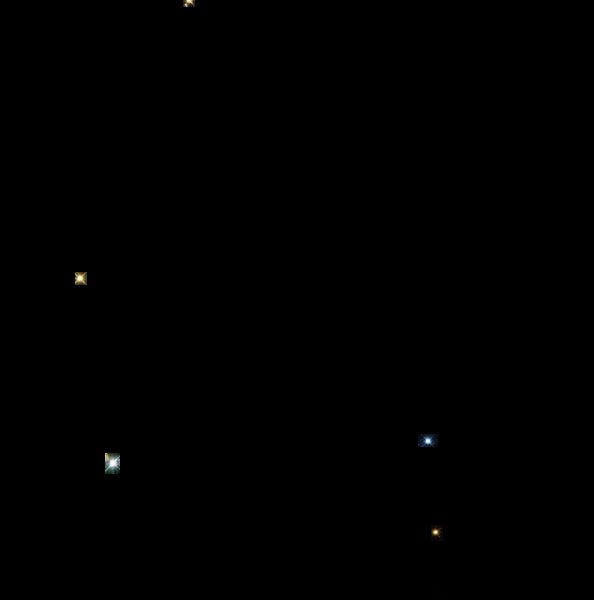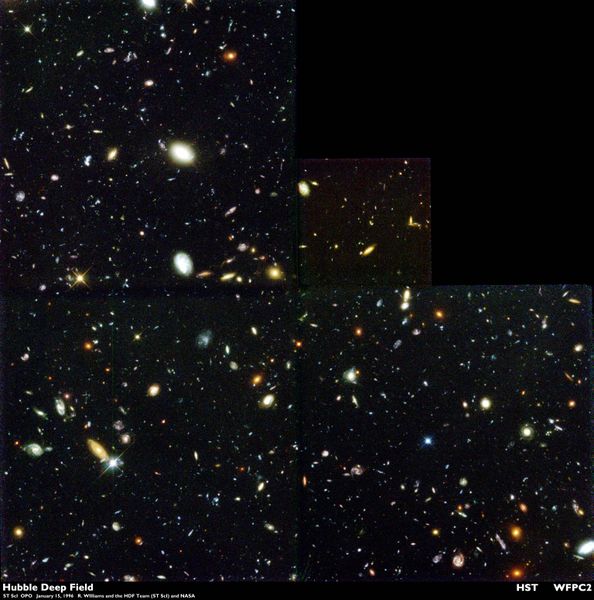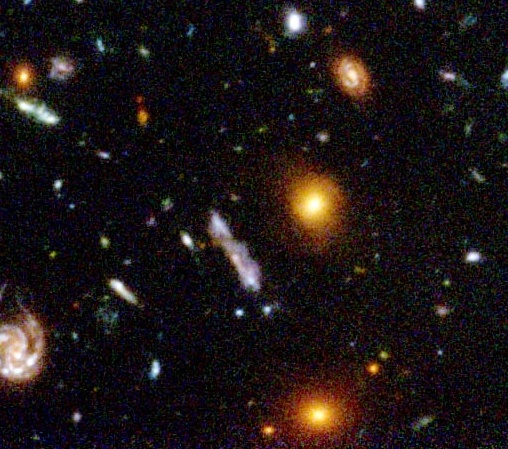As I write this, the Space Shuttle Atlantis has just blasted-off a few hours ago, headed for the Hubble Space Telescope. It's hard to believe that Hubble's been up there for more than 19 years now, and has helped revolutionize our understanding of the Universe, from measuring the Hubble constant to discovering Dark Energy. It continues to dazzle us even today.
While you can read about the servicing mission that's going on here, I'm going to focus on saying goodbye to one special instrument this week: WFPC2. (If you want to sound like an astronomer, it's pronounced WHIFF-pic-too.)
This camera, the Wide Field and Planetary Camera 2, installed in 1993, has been taking some of the greatest pictures the Hubble Space Telescope (or any telescope) has ever seen. Today will be its last day on the telescope, and this week I will be doing a five-part special on the five greatest images this camera has taken over its 16-year history. Let's cut right to it.
Battle not with monsters, lest ye become a monster. And if you gaze long into the abyss, the abyss also gazes into you. --F. Nietzsche
When you look up into the night sky, in some places there are stars, and in other places is just a black, empty abyss. You can see more stars with binoculars than your naked eye, and more with a telescope than with binoculars. But, at some point, you will have seen it all.
Well, in 1995, they decided to do an interesting experiment with the Hubble Space Telescope. Let's take a blank patch of sky, one with practically no stars in it, one with no known galaxies, clusters, or -- pretty much -- anything of interest in it. And let's point our telescope at it, for days, and let's see what shows up.

This image is only one degree on each side, or only 0.005% of the night sky. So you can appreciate just how miniscule this area is: the night sky is about 20,000 square degrees, while that little area is less than 0.002 square degrees! There are five faint stars in this field, and -- before Hubble -- they were the only things we knew of in this area. It looked like this:

Over the span of 10 days, WFPC2 took 342 images of this abyss, staring at this tiny, black patch of sky where nothing seemed to be, counting one photon here, one photon there, and often not seeing a single thing for minutes on end. At the end of 10 days, they stitched it all together, and here's what they found:

(And click here for the full-size version.)
Do you know how remarkable this is? Every point of light in this image that wasn't one of the five stars identified up top is its own galaxy! We had no idea how deep, how dense, and how full of stuff the Universe is until we took this picture. Do you have any idea how many galaxies are in this image? Any idea -- in less than 0.002 square degrees -- how many galaxies there are? Well, let's just take 3% of this image, blown-up, of course, so you can count.

And remember, every single blob, blur, or distant luminous dot is a galaxy! There's about 130, according to my estimates, more or less. If we do the math and extrapolate this to the entire night sky in both hemispheres (about 40,000 square degrees), we get that there are 10^11 galaxies in the Universe, or 100,000,000,000 galaxies!
Keep something else in mind here: 100 years ago, we thought we were the only one. I don't know how I'm going to find 4 other images from WFPC2 to compete with this one, but this is my favorite, and just creating it totally changed our view of the Universe, and how vast and full of stuff it actually is!
|


The deep field image definitely has to be one of the most awe inspiring images ever taken. Nothing else I've ever seen so profoundly illustrates to me the infinite breadth into which the imagination may pierce.
"Space is big - really big - you just won't believe how vastly, hugely mind-bogglingly big it is."
Douglas Adams
Indeed, this is mindbogglingly cool.
The blown up image makes tears come to my eyes from being so utterly amazing.
Photos taken by the Hubble are awe inspiring. I'm a writer--and I can't think of anything else to say about them. It just leaves me speechless.
Mind blown, insert alcohol
The latest terrestial telescopes have better resolution than Hubble in visible light, but they can't compete in infrared or ultraviolet. (A hint for selecting those other four images...)
Ethan,
Not to bust your balls or anything, but why does it look like you've cropped the image to show the five original objects in the photos?
Its too bad they couldn't finish the photo collage.
If all the money ever spent on space missions by all the world's space exploring nations had led only to Hubble, it would still have been worth every penny.
crap, there goes my brains all over the walls and ceilings.
The "collage" is as finished as it can be. That's what WFPC/2's viewing window looks like. The multiple images used to form the overall Deep Field were overlaid on each other, not laid out side-by-side, to form the entire image, as if to create one really, really long exposure.
You mean, those aren't the campfires of my ancestors?
I love how very very tiny and insignificant the Deep Field makes me feel in my gut. Certainly robs us of any self-importance we may feel. It also gives me a funny feeling of hope; I guess it is hope that there are other planets out there just as beautiful as Earth where benevolent beings live in harmony.
When that image first came out I was going to be an astronomer for about five years (I was about 12) to bad I am bad at math.
You might not be the right person to ask about this Ethan but you are a physicist so it might work. Why canât the shuttle get to the ISS from Hubble? As I understand it Hubble is much higher then ISS it would seem to me they would just have to slow down a bit and fall down to the lower orbit.
I knew that the Universe is very very big. I knew that there are trilions of galaxies. But numbers doesn't stimulate my imagination as pictures. It's just amazing...
Angela, I disagree. The deep field image dosent make me feel small at all, it makes me feel just how wonderful the universe really is. With all that... stuff... out there, literally anything is possible. That humans in our tiny corner of a relatively average galaxy can see just how much is out there.
Between the mysteries of the Hubble deep field, discovery of exoplanets, the CfA2 Great Wall, and the Great Attractor... it is a fascinating time to be alive.
The probable reason that the orbital "inclination" of the Hubble and the ISS are not compatible and a plane change in orbit takes a lot of energy.
The Deep Field image is the closest thing I could conceive of as a "God".
Just think, there is probably another civilization taking a picture of our 'MILKY WAY' galaxy.
Thanks for posting great little articles like this. Blows my mind and is very educational.
All this in 6 days. No wonder he took a day off.
You are cited at Daily Kos for these excellent posts. My handle at DK is the same as here.
Thank you for the light.
Photoshopped. There are no black arrows with text floating around the Hubble. Everyone knows that.
Joe, it is photoshopped. (Or, more probably, TVTie-d.) These are 342 individual images stitched together. Of course, we just call it "image processing".
Billy, if they did, they'd see us as we were billions and billions of years ago!
Now, can anybody really deny the existence of an intelligent creator?
yes jerryd we can deny it, in fact this goes a long way towards making your flying spaghetti monster fairy-tale more irrelevant.
What if each of those galaxies are actually our own, from eons ago, after some bizarre cosmic event caused this galaxy to speed through space at multiples of c? Well, its fun to think about anyway.
I don't know if "aliens" have ever been to our planet or not, but I am just certain, out of all of those galaxies, we can not be the single outpost of life in the universe.
This screams out. People of the planet earth, get over yourselves. Your not that important, just as I suspected. SS
Dear Ethan Siegel,
You peen.
You ruined my joke. I was referring to the diagram of the Hubble. It was funny. I was insinuating that the diagram was an actual photo. Saying a photo is photoshopped is the most ass-hat thing to do on a logical and enjoyable little blog like this.
You sir, have taken all of the fun out of me being an ass-hat.
Sincerely yours,
Joe Cool
Great job done!! Loved reading this. Had seen this on Boston's big picture also, but this is the first hand account.
How do you know that all those images showing up are galaxies and not individual stars?
There's a really great video about the Hubble Deep Field over at deepastronomy.com. I recommend EVERYONE take a look.
Incredible! How big universe is? I just can't imagine. Great stuff! Keep it up.
These images are beyond most peoples comprehension [including mine] they are phenomenal,stunning beyond belief, they are a wonder of the modern age, can someone please tell me where heaven starts,,
All of you people are freaks! Jesus put the lights in the sky. there is nothing fascinating about that. they are his jewels the were given to him upon his entry into the kingdom of heaven. If you listen to the word of jesus christ you will find all these phony science questions will be answered indefinitely.
"And Jesus said unto them ... , "If ye have faith as a grain of mustard seed, ye shall say unto this mountain, Remove hence to younder place; and it shall remove; and nothing shall be impossible to you."
Romans 1:17
If those images are real, that's fantastic and mind blowing! Only Hubble can deliver such awesome images.